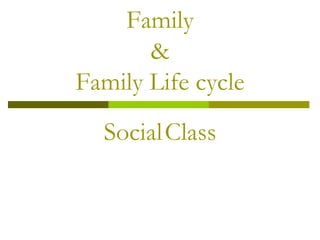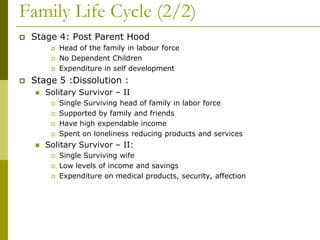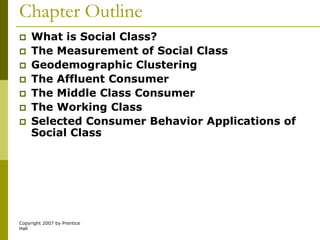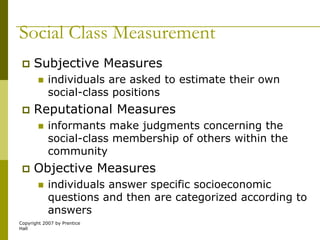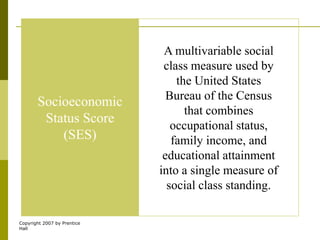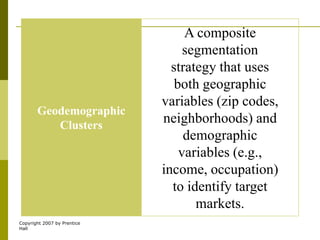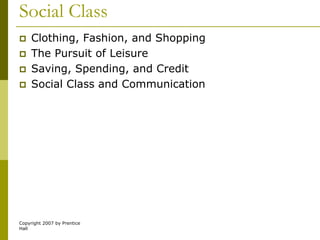Consumer Behaviour -Family, social class & life cycle
- 1. Family &Family Life cycleSocialClass
- 2. What is a Family?Familyis defined as a group of two or more people (one of whom is a householder) related by birth, marriage or adoption and residing togetherHousehold:Is a family and any unrelated person residing in the same house and consuming food from a common kitchen at least once a dayTwo types of household:Family HouseholdInstitutional Household e.g. HostelAll families are households but all households are not families
- 3. Types of FamilyFamily of OrientationConsist of one’s parents and eldersProvides orientation towardsSocial: Religion, Politics, EconomicsEmotional: Self Worth, Ambition, Love and CareFamily of ProcreationConsist of one’s spouse and childrenMost important buying unit in a marketThe influence of Family of Orientation decreases with Age
- 4. Types of FamilyTraditional Family Types:Married Couple:Simplest type of family consisting of husband and wifeNuclear Family:Consist of Husband Wife and at least one childExtended Family:Consist of a nuclear family with at least one grand parentJoint Family: Blood relatives and their spouses with kids staying togetherNew Modes of FamilyBlended Family:A family in which either or both partner were previously marriedSingle Parent Family:A family in which only one of the parent is presentUnmarried Family:Parents, unmarried, but living togetherCommunal Family:A group of families living together and sharing responsibility
- 5. Figure 10.11 A Simple Model of the Socialization ProcessYoung PersonFriendsOther Family MembersInfluence More ExpressiveAttitudes/BehaviorStyle
- 6. Fashion
- 7. Fads
- 8. “In/Out”
- 9. Acceptable consumer behaviorInfluence More BasicValues/BehaviorMoral/religious principles
- 16. Functions of a FamilyProvides Economic Well BeingProvides Emotional SupportProvides Suitable Life StyleProvides Social RelationshipsProvides Morals and Ethical ValuesProvides Religious ValuesProvides Interpersonal Skills
- 17. Family Life Cycle (1/2)Stage 1 :BachelorhoodFew Financial BurdensFashion and Recreation OrientedStage 2: Newly Married CoupleFinancially better offHighest purchase rate of consumables and durablesRomantically inclinedStage 3 : Parenthood Elementary school stageYoungest child < 6 years of ageLow Liquid AssetsHigh purchase of baby food & baby oriented productsHigh school stage Youngest child >= 6 years of ageFinancially better offCollege PhaseAll children still financially dependentHigh family influence on purchasesMajor expense on higher education
- 18. Family Life Cycle (2/2)Stage 4: Post Parent HoodHead of the family in labour forceNo Dependent ChildrenExpenditure in self developmentStage 5 :Dissolution :Solitary Survivor – IISingle Surviving head of family in labor forceSupported by family and friendsHave high expendable incomeSpent on loneliness reducing products and servicesSolitary Survivor – II:Single Surviving wifeLow levels of income and savingsExpenditure on medical products, security, affection
- 19. Table 10.6 Eight Roles in the Family Decision-Making ProcessROLEDESCRIPTIONInfluencersFamily member(s) who provide information to other members about a product or serviceGatekeepersFamily member(s) who control the flow of information about a product or service into the familyDecidersFamily member(s) with the power to determine unilaterally or jointly whether to shop for, purchase, use, consume, or dispose of a specific product or serviceBuyersFamily member(s) who make the actual purchase of a particular product or servicePreparersFamily member(s) who transform the product into a form suitable for consumption by other family membersUsersFamily member(s) who use or consume a particular product or serviceMaintainersFamily member(s) who service or repair the product so that it will provide continued satisfaction.DisposersFamily member(s) who initiate or carry out the disposal or discontinuation of a particular product or service
- 20. Household Decision Making ProcessInfluencer(Children)Communication targeted at ChildrenInitiator(Parents, Children)DecisionMaker(Parents, Children)Purchaser(Parents)Communication targeted at ParentsUser(Parents,Children)InformationGathering
- 21. Types of Family DecisionsHusband Dominated Decisions Husband takes the purchase decisionsTraditionally in products like Automobiles, Alcohol, InsuranceWife Dominated DecisionsWife takes the purchase decisionsTraditionally in products like household maintenance items, food and kitchen appliancesJoint Decision MakingBoth husband and wife make the decisionTraditionally in School choice, living room furniture, vacationsChild Dominated Decision MakingChild makes the “final product” decisionTraditionally on children related itemsUnilateral Decision MakingTaken by any member of the familyTraditionally on Personal Care items, low priced goodsThese Traditional Roles are Changing
- 22. Conflict ResolutionFamily Decisions are bound to create conflictConflicts are resolved by:Bargaining:Reaching a compromise on which product to buyImpression Management:Misrepresentation of facts in order to create favorable impressionsUse of Authority:Claiming superior authority to resolve the conflictReasoning:Using logical arguments to resolve the conflictPlaying on Emotions:Using emotions to resolve the conflictAdditional Information:Getting additional Data or Third Party Information
- 24. Consumer SocializationConsumer Socialization is the process by which people acquire skills, knowledge and attitudes relevant to their functioning as consumers in the marketplaceContents of Consumer Socialization:Consumer Skills:Skills necessary for purchase and understand money, budgeting, product evaluationConsumption Preferences:Are knowledge, attitudes and values that cause people to attach differential evaluation to products, brands and retail outletsConsumption Attitudes:Are cognitive orientation towards market place stimulus such as advertising, sales persons, warranties etc.
- 25. Copyright 2007 by Prentice HallChapter 11Social Class and Consumer Behavior
- 26. Copyright 2007 by Prentice HallChapter OutlineWhat is Social Class?The Measurement of Social ClassGeodemographic ClusteringThe Affluent ConsumerThe Middle Class ConsumerThe Working ClassSelected Consumer Behavior Applications of Social Class
- 27. Copyright 2007 by Prentice HallSocial ClassThe division of members of a society into a hierarchy of distinct status classes, so that members of each class have either higher or lower status than members of other classes.
- 28. Copyright 2007 by Prentice HallSocial Class Is HierarchalStatus is frequently thought of as the relative rankings of members of each social class
- 29. Copyright 2007 by Prentice HallTable 11.2 Percent Distribution of Five-Category Social-Class MeasureSOCIAL CLASSES PERCENTAGEUpper 4.3Upper-middle 13.8Middle 32.8Working 32.3Lower 16.8Total percentage 100.0
- 30. Copyright 2007 by Prentice HallSocial Class MeasurementSubjective Measuresindividuals are asked to estimate their own social-class positionsReputational Measuresinformants make judgments concerning the social-class membership of others within the communityObjective Measuresindividuals answer specific socioeconomic questions and then are categorized according to answers
- 31. Copyright 2007 by Prentice HallObjective MeasuresSingle-variable indexesOccupationEducationIncomeOther VariablesComposite-variable indexesIndex of Status CharacteristicsSocioeconomic Status Score
- 32. Geo demographic clustering“Birds of a feather flock together”Families of similar socioeconomic backgrounds tend to reside in the same neighborhoods or communities. “They cluster together”Dispersed communities with similar geographic profilesLocated by PINCODES
- 33. Copyright 2007 by Prentice HallIndex of Status Characteristics (ISC)A composite measure of social class that combines occupation, source of income (not amount), house type/dwelling area into a single weighted index of social class standing.
- 34. Copyright 2007 by Prentice HallSocioeconomic Status Score (SES)A multivariable social class measure used by the United States Bureau of the Census that combines occupational status, family income, and educational attainment into a single measure of social class standing.
- 35. Copyright 2007 by Prentice HallGeodemographic ClustersA composite segmentation strategy that uses both geographic variables (zip codes, neighborhoods) and demographic variables (e.g., income, occupation) to identify target markets.
- 36. Copyright 2007 by Prentice HallPRIZM (Potential Rating Index by Zip Market)A composite index of geographic and socioeconomic factors expressed in residential zip code neighborhoods from which geodemographic consumer segments are formed.
- 37. Copyright 2007 by Prentice HallThe Affluent ConsumerEspecially attractive target to marketersGrowing number of households can be classified as “mass affluent” with incomes of at least $75,000Some researchers are defining affluent to include lifestyle and psychographic factors in addition to incomeHave different medial habits than the general population
- 38. Copyright 2007 by Prentice HallWhat Is the Middle Class?The “middle” 50 percent of household incomes - households earning between $22,500 and $80,000Households made up of college-educated adults who use computers, and are involved in children’s educationLower-middle to middle-middle based on income, education, and occupation (this view does NOT include upper-middle, which is considered affluent)
- 39. Copyright 2007 by Prentice HallThe Middle ClassThere is evidence that the middle class is slowly disappearing in the U.S.Growth of middle class in some Asian and Eastern European countriesMany companies offering luxury to the masses with near-luxury models and goods
- 40. Copyright 2007 by Prentice HallThe Working Class?Households earning $40,000 or less control more than 30 percent of the total income in the U.S.These consumers tend to be more brand loyal than wealthier consumers.
- 41. Copyright 2007 by Prentice HallDiscussion QuestionWhat types of products are targeted to the working class?What issues must marketers consider when targeting their ads to the working class?
- 42. Copyright 2007 by Prentice HallThe Techno ClassHaving competency with technologyThose without are referred to as “technologically underclassed”Parents are seeking computer exposure for their childrenGeeks now viewed as friendly and fun
- 43. Copyright 2007 by Prentice HallConsumer Behavior and Social ClassClothing, Fashion, and ShoppingThe Pursuit of LeisureSaving, Spending, and CreditSocial Class and Communication
- 44. Copyright 2007 by Prentice HallClass Situations, Self-Perceptions, and Financial OrientationsFigure 11-9
